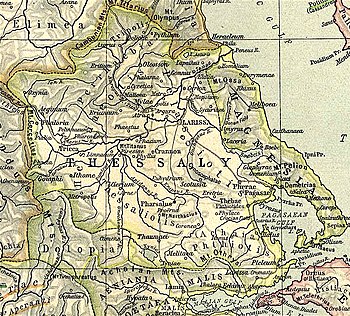39°46′34″N 22°07′20″E / 39.77615°N 22.12219°E

Cyretiae or Chyretiai or Kyretiai (Greek: Χυρετίαι)[1] was a town and polis (city-state)[2] of Perrhaebia in ancient Thessaly, frequently mentioned in the Roman wars in Greece. It was plundered by the Aetolians in 200 BCE,[3] was taken by Antiochus III, 191 BCE, but recovered by Marcus Baebius Tamphilus and Philip V of Macedon in the same year,[4] and was attacked by Perseus of Macedon, following the surrender of nearby Doliche, Pythium, and Azorus in 171 BCE. In the last event, after a first assault attempt was repulsed, the attackers on the second day of the siege obtained the surrender of the defenders.[5]
Cyretiae appears in several inscriptions that have come down to us, among which stand out: one dated between 375-350 BCE, containing a joint dedication to Apollo of the cities of Perrhaebia,[2] a letter from Titus Quinctius Flamininus to the Cyretiaeans that can be dated to 195 BCE, and a decree of proxeny dated to 191 BCE that contains the names of several tagoi.[6]
Cyretiae is located at a site in the modern village of Domeniko.[7][8] Its acropolis occupied the hill, on which now stands the church of St. George, and excavations have been undertaken.[9]
References
edit- ^ Ptolemy. The Geography. Vol. 3.13.44.
- ^ a b Mogens Herman Hansen & Thomas Heine Nielsen (2004). "Thessaly and Adjacent Regions". An inventory of archaic and classical poleis. New York: Oxford University Press. p. 722. ISBN 0-19-814099-1.
- ^ Livy. Ab urbe condita Libri [History of Rome]. Vol. 31.41.
- ^ Livy. Ab urbe condita Libri [History of Rome]. Vol. 36.10, 13.
- ^ Livy. Ab urbe condita Libri [History of Rome]. Vol. 42.53.
- ^ Jorge Martínez de Tejada Garaizábal, Instituciones, sociedad, religión y léxico de Tesalia de la antigüedad desde la época de la independencia hasta el fin de la edad antigua (siglos VIII AC-V DC), tesis doctoral, pp.235. Madrid: Universidad Complutense de Madrid (2012). Archived 2018-08-29 at the Wayback Machine (in Spanish)
- ^ Lund University. Digital Atlas of the Roman Empire.
- ^ Richard Talbert, ed. (2000). Barrington Atlas of the Greek and Roman World. Princeton University Press. p. 55, and directory notes accompanying. ISBN 978-0-691-03169-9.
- ^ Smith, William, ed. (1854–1857). "Cyretiae". Dictionary of Greek and Roman Geography. London: John Murray.
This article incorporates text from a publication now in the public domain: Smith, William, ed. (1854–1857). "Cyretiae". Dictionary of Greek and Roman Geography. London: John Murray.